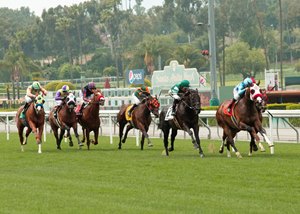CHRB Backs Bill That Would Allow it to Act Faster


The California Horse Racing Board approved its support of SB 469, a bill that would allow the CHRB to immediately suspend a license to conduct a race meeting if needed to protect equine health and welfare.
It was one of several items the CHRB undertook at its May 23 meeting at Santa Anita Park to continue to improve protocols designed for the safety of horses and riders.
SB 469 is making its way through the California state legislature. It would add equine health and welfare to what could be considered an emergency, allowing the CHRB to vote on suspending racing without having to adhere to the 10-day notice of a meeting required by California law.
The May 23 meeting began with a long and, at times, strident public-comment portion. Several animal welfare activists called for outlawing racing in California, with television news cameras recording the speeches. Those comments arose in the wake of the rash of equine fatalities this past winter at Santa Anita, a situation that closed the track through most of March.
The equine fatalities have led to increased safety protocols, as well as more stringent medication rules.
The CHRB at the May meeting approved racing licenses at Los Alamitos Race Course, Del Mar, and several Northern California tracks that are under the auspices of the California Authority of Racing Fairs. All had adopted increased safety protocols and medication rules similar to those now in place at Santa Anita through agreement with the Thoroughbred Owners of California.
Most of the animal welfare activists and TV cameras left following the public-comment portion of the meeting. At the close of the meeting, CHRB chairman Chuck Winner announced that going forward, the public-comment portion would be held at the end of each meeting "so people can hear what actions the board takes before making their comments." He noted this is the way other such meetings are typically conducted.
Rick Baedeker, the CHRB executive director, also referenced the public comments, the number and stridency of which have skyrocketed at recent meetings. He noted some people have "very little interest in the facts" and then made specific points about California's racing industry.
"Our testing procedures are among the most stringent in the world," Baedeker said. "We have the finest lab of any racing lab in the world right here in California."
Baedeker noted that California tests samples of horses before and after racing and out of competition for more than 1,800 known substances. He said of the 41,125 samples tested during the 2017-18 fiscal year, six were positive for performance-enhancing substances, including one for sodium bicarbonate and one for caffeine.
"In my opinion, other sports don't hold a candle to the scrutiny that is applied to racing in California," Baedeker said. "Everything we do is aboveboard and in the open. Every ruling is published. Every fatality is published. I think we pay a price for our transparency. I'm not saying that's wrong—that is the right thing to do."
The May agenda included an item to discuss changes to CHRB rules on the limits of furosemide use in 2020 and beyond. The board tabled that item and referred it to its medication committee.
In other action, the board approved the authorization of Fasig-Tipton to conduct horse sales at Santa Anita. Fasig-Tipton has scheduled the Santa Anita 2-Year-Olds in Training Sale for June 5 and a yearling sale for Sept. 25.
The board also approved an agreement to alter the distribution of some market access fees in advanced deposit wagers to fund a co-op marketing program. This was done because legislation funding the California Marketing Committee had expired. This new agreement will allow the continuation of funding for the Ship & Win program and on-track rebates for high-volume bettors. Baedeker noted that this is a change in distribution of fees, not any increase in takeout.
